Potential Emissions of Insecticide VOCs and Their Correlations between Agricultural Emissions and Meteorological Factors
Abstract
1. Introduction
2. Materials and Methods
2.1. Determining the EP Value of Insecticides
2.2. Measurement of InsecticideVOCs after Actual Application
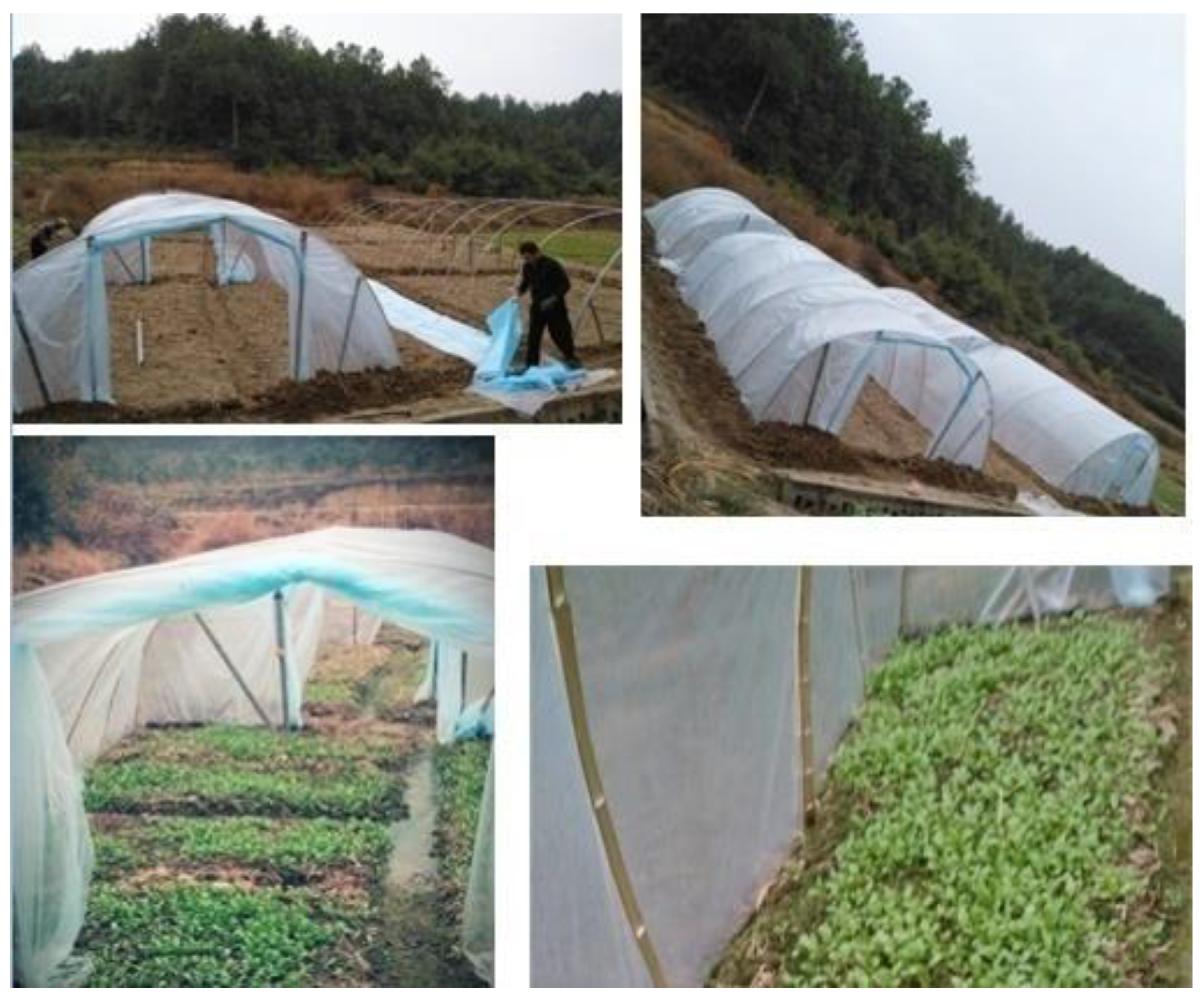
3. Results
3.1. Correlations of EP, MC and TM Value of Different Formulations
3.2. Correlations of Meteorological Factors on VOCs Emitted from Typical Insecticides
4. Discussion
5. Conclusions
- (1)
- The EPs of nine insecticide samples ranged from 12.30% to 81.30%, with a median of 41.59% and a mean of 45.41%.There were no correlations either between EP and TM, nor between MC and TM in the whole sample analysis, but there was a weak positive correlation between MC and EP;
- (2)
- Compared the actual emission and potential emission of insecticide VOCs, the average AER (%) of each formulation was ranked as: EW (72.12) > SL (63.03) > SC (58.69) > EC (52.95) >AS (48.76); and
- (3)
- Analyzing the emission characteristics of insecticide VOCs during application and the influence of formulations and meteorological factors by principal component analysis, it was found that AER value was significantly positively correlated with temperature change, at the same time, significantly negatively correlated with relative humidity and atmospheric pressure. Among all the meteorological elements, the temperature had the strongest correlation with the AER.
Author Contributions
Funding
Institutional Review Board Statement
Informed Consent Statement
Data Availability Statement
Acknowledgments
Conflicts of Interest
References
- Caron-Beaudoin, É.; Whyte, K.P.; Bouchard, M.F.; Chevrier, J.; Haddad, S.; Copes, R.; Frohlich, K.L.; Dokkie, D.; Juul, S.; Bouchard, M.; et al. Volatile organic compounds (VOCs) in indoor air and tap water samples in residences of pregnant women living in an area of unconventional natural gas operations: Findings from the EXPERIVA study. Sci. Total Environ. 2022, 805, 150242. [Google Scholar] [CrossRef] [PubMed]
- Kumar, A.; Howard, C.J.; Derrick, D.; Malkina, I.L.; Mitloehner, F.M.; Kleeman, M.J.; Alaimo, C.P.; Flocchini, R.G.; Green, P.G. Determination of Volatile Organic Compound Emissions and Ozone Formation from Spraying Solvent-based Pesticides. J. Environ. Qual. 2011, 40, 1423–1431. [Google Scholar] [CrossRef] [PubMed]
- Gao, G.; Zhang, X.; Yan, Z.; Cheng, Y.; Li, H.; Xu, G. Monitoring Volatile Organic Compounds in Different Pear Cultivars during Storage Using HS-SPME with GC-MS. Foods 2022, 11, 3778. [Google Scholar] [CrossRef] [PubMed]
- Mo, Z.; Lu, S.; Shao, M. Volatile Organic Compound (VOC) Emissions and Health Risk Assessment in Paint and Coatings Industry in the Yangtze River Delta, China. Environ. Pollut. 2021, 269, 115740. [Google Scholar] [CrossRef]
- Liu, G.; Sun, S.; Zou, C.; Wang, B.; Wu, L.; Mao, H. Air pollutant emissions from on-road vehicles and their control in Inner Mongolia, China. Energy 2022, 238, 121724. [Google Scholar] [CrossRef]
- Pusede, S.E.; Cohen, R.C. On the observed response of ozone to NOx and VOC reactivity reductions in San Joaquin Valley California 1995-present. Atmos. Chem. Phys. 2012, 31, 311–315. [Google Scholar]
- Sarigiannis, D.A.; Karakitsios, S.P.; Gotti, A.; Liakos, I.L.; Katsoyiannis, A. Exposure to major volatile organic compounds and carbonyls in European indoor environments and associated health risk. Environ. Int. 2011, 37, 743–765. [Google Scholar] [CrossRef]
- Yang, K.; Wang, C.; Xue, S.; Li, W.; Liu, J.; Li, L. The identification, health risks and olfactory effects assessment of VOCs released from the wastewater storage tank in a pesticide plant. Ecotoxicol. Environ. Saf. 2019, 184, 109665. [Google Scholar] [CrossRef]
- Zheng, H.; Kong, S.; Chen, N.; Niu, Z.; Zhang, Y.; Jiang, S.; Yan, Y.; Qi, S. Source apportionment of volatile organic compounds: Implications to reactivity, ozone formation, and secondary organic aerosol potential. Atmos. Res. 2021, 249, 105344. [Google Scholar] [CrossRef]
- Chen, Y.; Su, W.; Xing, C.; Yin, H.; Lin, H.; Zhang, C.; Liu, H.; Hu, Q.; Liu, C. Kilometer-level glyoxal retrieval via satellite for anthropogenic volatile organic compound emission source and secondary organic aerosol formation identification. Remote Sens. Environ. 2022, 270, 112852. [Google Scholar] [CrossRef]
- Gkatzelis, G.I.; Coggon, M.M.; McDonald, B.C.; Peischl, J.; Gilman, J.B.; Aikin, K.C.; Robinson, M.A.; Canonaco, F.; Prevot, A.S.H.; Trainer, M.; et al. Observations Confirm that Volatile Chemical Products Are a Major Source of Petrochemical Emissions in U.S. Cities. Environ. Sci. Technol. 2021, 55, 4332–4343. [Google Scholar] [CrossRef] [PubMed]
- Wu, K.; Yang, X.; Chen, D.; Gu, S.; Lu, Y.; Jiang, Q.; Wang, K.; Ou, Y.; Qian, Y.; Shao, P.; et al. Estimation of biogenic VOC emissions and their corresponding impact on ozone and secondary organic aerosol formation in China. Atmos. Res. 2020, 231, 104656. [Google Scholar] [CrossRef]
- Hui, L.; Liu, X.; Tan, Q.; Feng, M.; An, J.; Qu, Y.; Zhang, Y.; Deng, Y.; Zhai, R.; Wang, Z. VOC characteristics, chemical reactivity and sources in urban Wuhan, central China. Atmos. Environ. 2020, 224, 117340. [Google Scholar] [CrossRef]
- Zhou, M.; Jiang, W.; Gao, W.; Zhou, B.; Liao, X. A high spatiotemporal resolution anthropogenic VOC emission inventory for Qingdao City in 2016 and its ozone formation potential analysis. Process Saf. Environ. Prot. 2020, 139, 147–160. [Google Scholar] [CrossRef]
- Liang, X.; Sun, X.; Lu, Q.; Ren, L.; Liu, M.; Su, Y.; Wang, S.; Lu, H.; Gao, B.; Zhao, W.; et al. VOC emission inventory of architectural coatings and adhesives for new buildings in China based on investigated and measured data. Atmos. Environ. 2021, 245, 118014. [Google Scholar] [CrossRef]
- Lewis, A.C.; Hopkins, J.R.; Carslaw, D.C.; Hamilton, J.F.; Nelson, B.S.; Stewart, G.; Dernie, J.; Passant, N.; Murrells, T. An increasing role for solvent emissions and implications for future measurements of volatile organic compounds. Philos. Trans. R. Soc. Math. Phys. Eng. Sci. 2020, 378, 20190328. [Google Scholar] [CrossRef]
- Chen, S.; Xu, Z.; Liu, P.; Zhuang, Y.; Jiang, M.; Zhang, X.; Han, Z.; Liu, Y.; Chen, X. Assessment of volatile organic compound emissions from pesticides in China and their contribution to ozone formation potential. Environ. Monit. Assess. 2022, 194, 737. [Google Scholar] [CrossRef]
- Pearson, J.K. European solvent VOC emission inventories based on industry-wide information. Atmos. Environ. 2019, 204, 118–124. [Google Scholar] [CrossRef]
- Lechhab, W.; Cincotta, F.; Lechhab, T.; Condurso, C.; Salmoun, F.; Cacciola, F.; Verzera, A. Preliminary Assessment of Occurrence, Potential Origin, and Human Health Risk of Volatile Organic Compounds in Uncontrolled Springs, North Morocco. Metabolites 2022, 12, 1213. [Google Scholar] [CrossRef]
- Lykogianni, M.; Bempelou, E.; Karamaouna, F.; Aliferis, K.A. Do pesticides promote or hinder sustainability in agriculture? The challenge of sustainable use of pesticides in modern agriculture. Sci. Total Environ. 2021, 795, 148625. [Google Scholar] [CrossRef]
- Siegel, M.; Starks, S.E.; Sanderson, W.T.; Kamel, F.; Hoppin, J.A.; Gerr, F. Organic solvent exposure and depressive symptoms among licensed pesticide applicators in the Agricultural Health Study. Int. Arch. Occup. Environ. Health 2017, 90, 849–857. [Google Scholar] [CrossRef] [PubMed]
- Toose, L.; Warren, C.; Mackay, D.; Parkerton, T.; Letinski, D.; Manning, R.; Connelly, M.; Rohde, A.; Fritz, B.; Hoffmann, W.C. Assessing the Fate of an Aromatic Hydrocarbon Fluid in Agricultural Spray Applications Using the Three-Stage ADVOCATE Model Framework. J. Agric. Food Chem. 2015, 63, 6866–6875. [Google Scholar] [CrossRef] [PubMed]
- Wu, Y.; An, Q.; Hao, X.; Li, D.; Zhou, C.; Zhang, J.; Wei, X.; Pan, C. Dissipative behavior, residual pattern, and risk assessment of four pesticides and their metabolites during tea cultivation, processing and infusion. Pest Manag. Sci. 2022, 78, 3019–3029. [Google Scholar] [CrossRef] [PubMed]
- CDPR (California Department of Pesticide Regulation). Pesticide Use Reporting—2018 Summary Data. 2018. Available online: https://www.cdpr.ca.gov/docs/pur/pur18rep/18_pur.htm (accessed on 19 January 2020).
- CDPR (California Department of Pesticide Regulation). Volatile Organic Compound (VOC) Emissions from Pesticides, Emission Inventory Reports and Data. 2019. Available online: https://www.cdpr.ca.gov/docs/emon/vocs/vocproj/voc_data_analysis.htm (accessed on 16 March 2021).
- OWD (Our World in Data). Pesticides—Our World in Data. 2021. Available online: https://ourworldindata.org/pesticides (accessed on 5 September 2022).
- The State Council of the People’s Republic of China. The Term Pesticide Is Defined as Follows in the Regulations on the Administration of Pesticides. 2022. Available online: http://www.gov.cn/gongbao/content/2017/content_5186961.htm (accessed on 5 September 2022).
- Porretta, D.; Mastrantonio, V.; Lucchesi, V.; Bellini, R.; Vontas, J.; Urbanelli, S. Historical samples reveal a combined role of agriculture and public-health applications in vector resistance to insecticides. Pest Manag. Sci. 2022, 78, 1567–1572. [Google Scholar] [CrossRef]
- CDPR (California Department of Pesticide Regulation). Estimation of Volatile Emission Potential of Pesticides by Thermogravimetry. 2005. Available online: https://www.cdpr.ca.gov/docs/emon/vocs/vocproj/tga_method_020905.pdf (accessed on 19 January 2020).
- Zeinali, M.; McConnell, L.L.; Hapeman, C.J.; Nguyen, A.; Schmidt, W.F.; Howard, C.J. Volatile organic compounds in pesticide formulations: Methods to estimate ozone formation potential. Atmos. Environ. 2011, 45, 2404–2412. [Google Scholar] [CrossRef]
- GB/T 1600-2021; Testing Method of Water for Pesticides. SAC (Standardization Administration of The People’s Republic of China), General Administration of Quality Supervision, Inspection and Quarantine of the PRC: Beijing, China, 2021. Available online: https://openstd.samr.gov.cn/bzgk/gb/newGbInfo?hcno=54E693A0F5DF1132DA47C71DB0A780B5 (accessed on 5 September 2022).
- HJ 1019-2019; Technical Guideline for Site Soil and Groundwater Sampling of Volatile Organic Compounds. MEE (Ministry of Ecology and Environment of the PRC): Beijing, China, 2019. Available online: https://www.mee.gov.cn/ywgz/fgbz/bz/bzwb/jcffbz/201905/W020190516584161547667.pdf (accessed on 5 September 2022).
- CMA (China Meteorological Administration). Analysis of Climate Background in Changsha. 2021. Available online: http://www.weather.com.cn/cityintro/101250101.shtml (accessed on 5 September 2022).
- CDPR (California Department of Pesticide Regulation). Nonfumigant Volatile Organic Compound (VOC) Regulations Product List. 2021. Available online: https://www.cdpr.ca.gov/docs/emon/vocs/vocproj/nonfum_voc_prod_list.pdf (accessed on 28 January 2022).
- Wei, H. The Environmental Impacts of Pesticide Use in Conventional and Organic Agriculture: Evidence from California. 2021. Available online: https://arefiles.ucdavis.edu/uploads/pub/2021/01/28/job_market_paper_hanlin_wei_152021.pdf (accessed on 5 September 2022).
- Zhan, Y.; Zhang, M.H. PURE: A web-based decision support system to evaluate pesticide environmental risk for sustainable pest management practices in California. Ecotoxicol. Environ. Saf. 2012, 82, 104–113. [Google Scholar] [CrossRef]
- Yates, S.R.; McConnell, L.L.; Hapeman, C.J.; Papiernik, S.K.; Gao, S.; Trabue, S.L. Managing agricultural emissions to the atmosphere: State of the science, fate and mitigation, and identifying research gaps. J. Environ. Qual. 2011, 40, 1347–1358. [Google Scholar] [CrossRef]
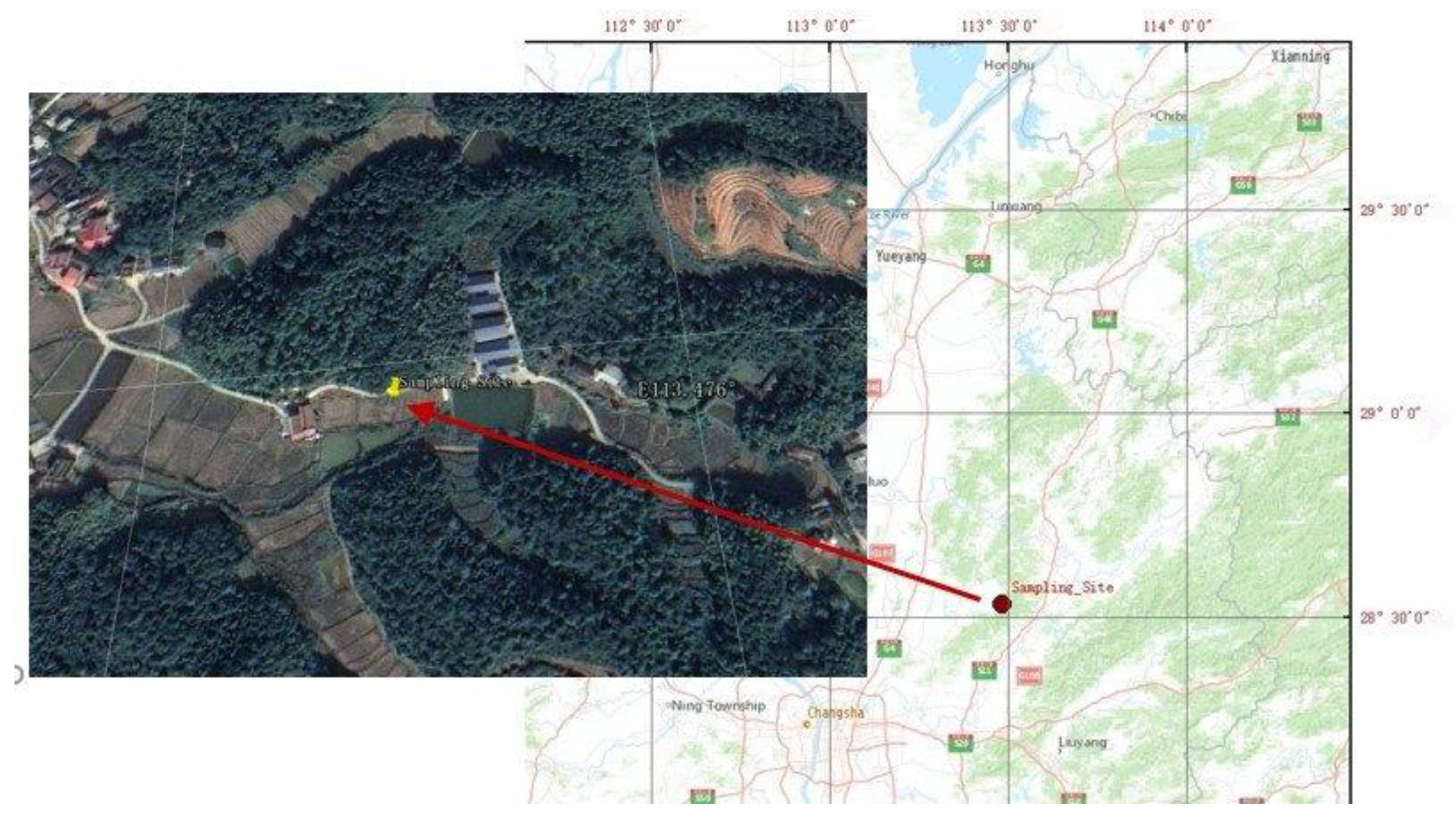
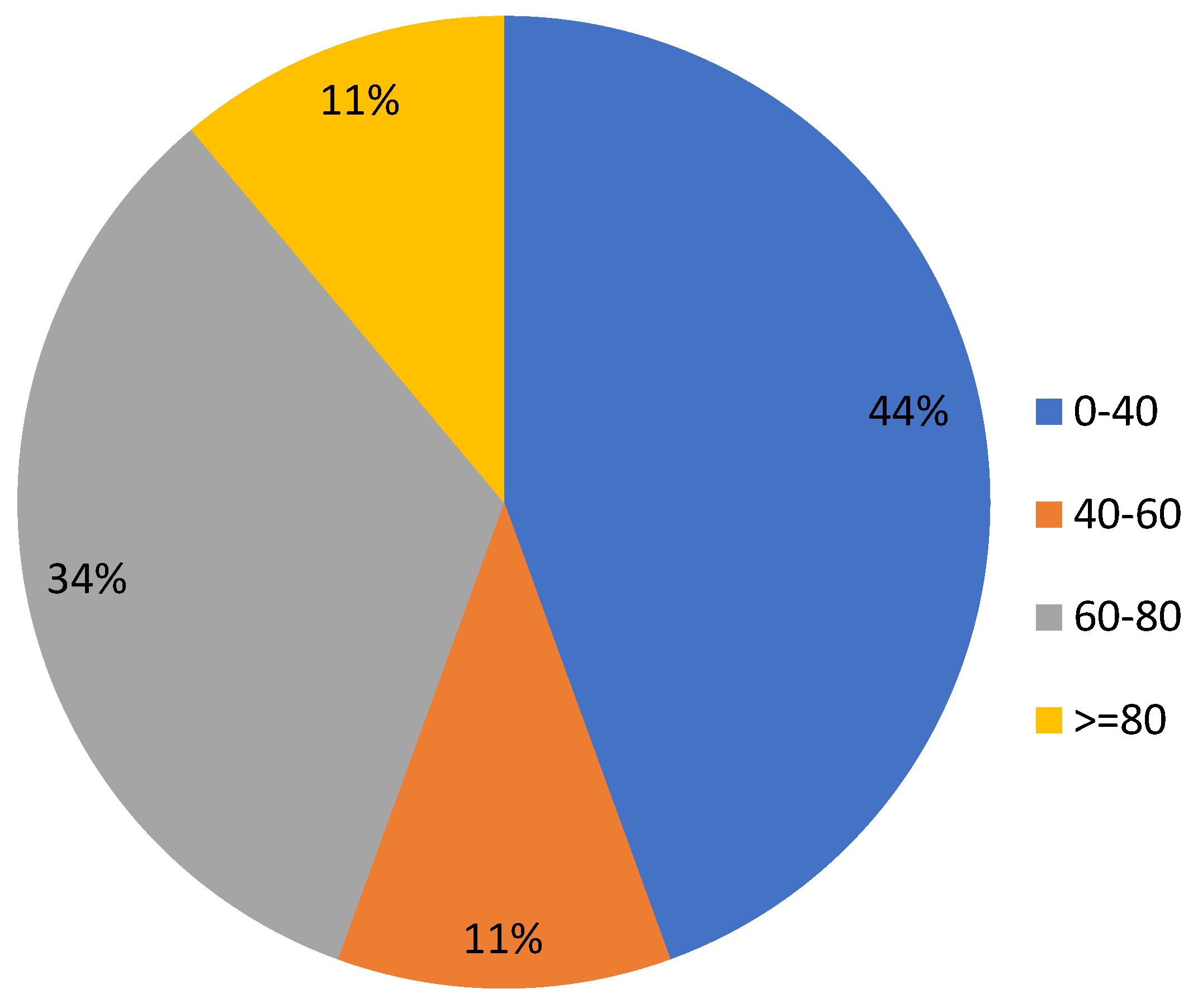
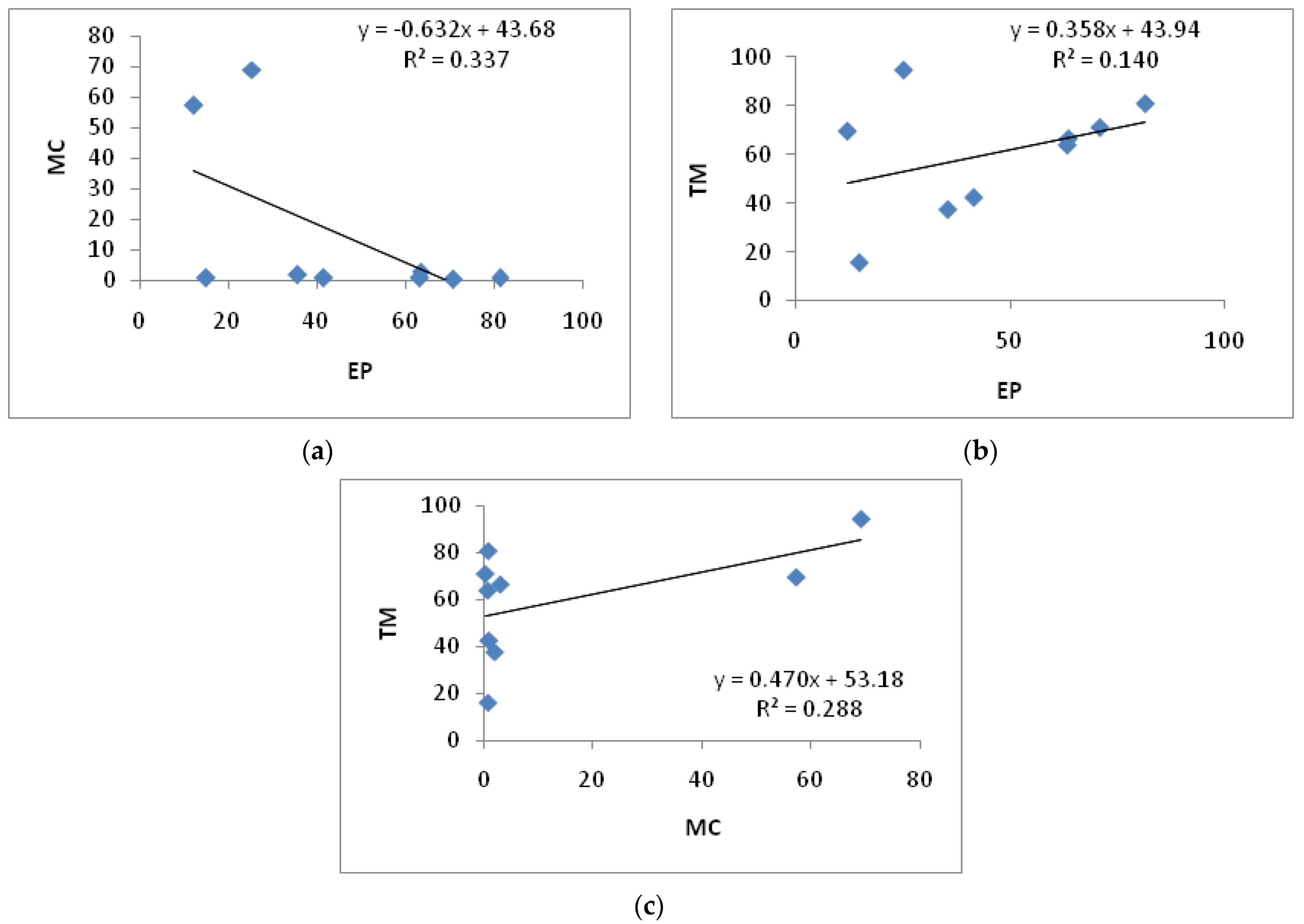
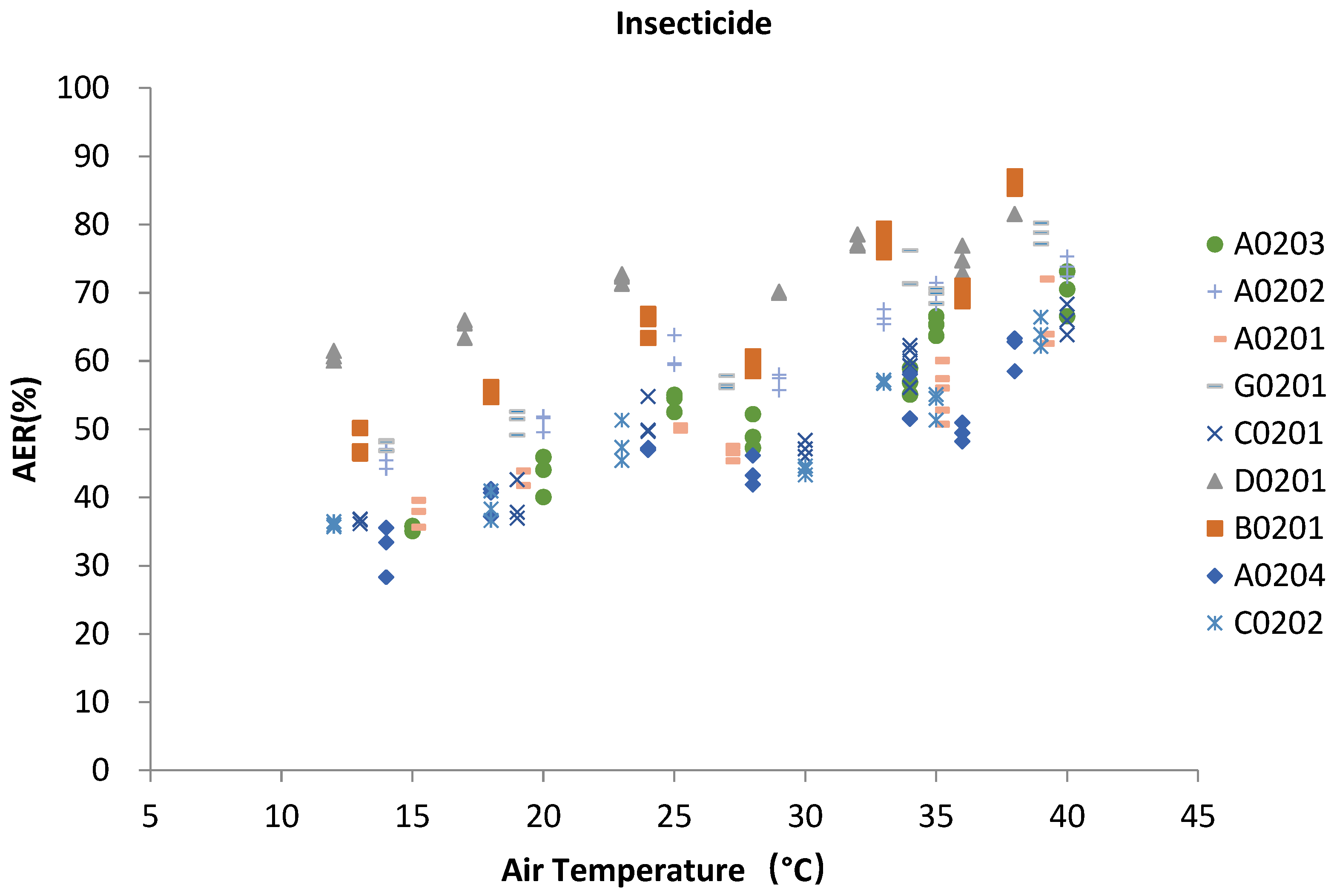
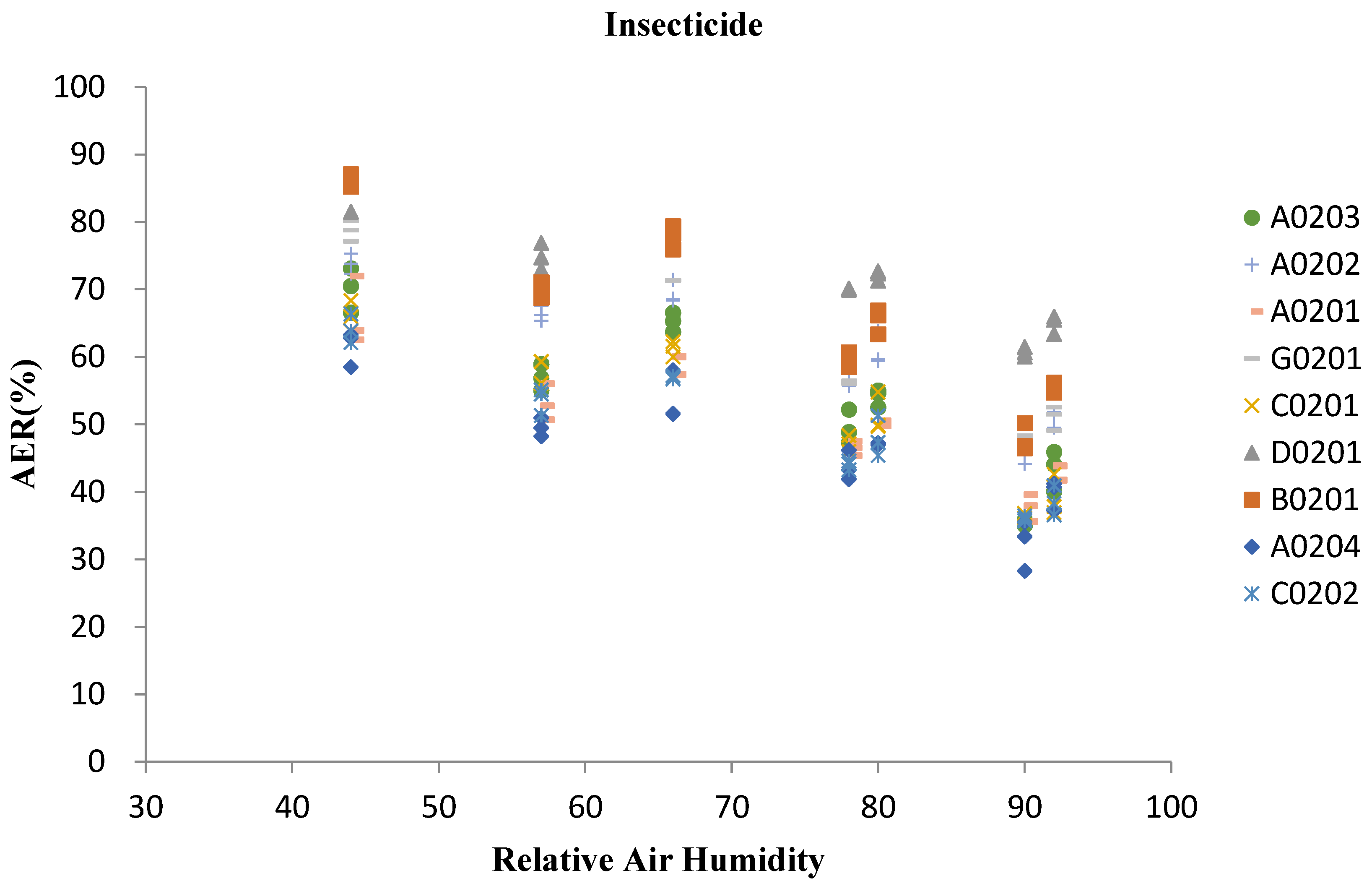



| Tested No. | Product No. | Pesticide Formulation | Active Ingredient | |
|---|---|---|---|---|
| Insecticide | A0201 | PD20095706 | Emulsifiable concentrate | Abamectin |
| A0202 | PD20121299 | Emulsifiable concentrate | Abamectin | |
| A0203 | PD20141452 | Emulsifiable concentrate | Abamectin | |
| A0204 | PD20120093 | Emulsifiable concentrate | Abamectin | |
| C0201 | PD20150289 | Suspension concentrate | Thiamethoxam | |
| C0202 | PD20094278 | Suspension concentrate | Bacillus thuringiensis | |
| B0201 | PD20140436 | Aqueous solution | Nitenpyram | |
| D0201 | PD20170562 | Emulsion (oil in water) | β-Cyfluthrin | |
| G0201 | PD20130350 | Soluble concentrate | Imidacloprid |
| Meteorological Element | Average | Maximum | Minimum |
|---|---|---|---|
| Temperature (°C) | 25.6 | 41.0 | 9.0 |
| Relative humidity (%) | 74.8 | 92.0 | 44.0 |
| Air pressure (hPa) | 1007.5 | 1021.0 | 998.0 |
| Tested No. | Insecticide Formulation | Active Ingredient | EP | MC | TM |
|---|---|---|---|---|---|
| A0201 | EC | Abamectin | 15.10 | 0.72 | 15.82 |
| A0202 | EC | Abamectin | 63.49 | 2.98 | 66.48 |
| A0203 | EC | Abamectin | 41.59 | 0.87 | 42.46 |
| A0204 | EC | Abamectin | 81.30 | 0.77 | 80.79 |
| C0201 | SC | Thiamethoxam | 12.30 | 57.25 | 69.55 |
| C0202 | SC | Bacillus thuringiensis | 63.21 | 0.65 | 63.86 |
| B0201 | AS | Nitenpyram | 35.59 | 1.93 | 37.52 |
| D0201 | EW | β-Cyfluthrin | 25.33 | 69.18 | 94.50 |
| G0201 | SL | Imidacloprid | 70.80 | 0.21 | 71.01 |
| Tested No. | Pesticide Formulation | Active Ingredient | AE (%) | AER (%) | ||||
|---|---|---|---|---|---|---|---|---|
| Average | Maximum | Minimum | Average | Maximum | Minimum | |||
| A0201 | EC | Abamectin | 7.68 | 10.87 | 5.38 | 50.85 | 71.98 | 35.61 |
| A0202 | EC | Abamectin | 38.48 | 47.80 | 28.06 | 60.61 | 75.29 | 44.19 |
| A0203 | EC | Abamectin | 22.26 | 30.42 | 14.59 | 53.52 | 73.13 | 35.07 |
| A0204 | EC | Abamectin | 38.07 | 51.46 | 23.00 | 46.82 | 63.29 | 28.29 |
| C0201 | SC | Thiamethoxam | 23.49 | 30.99 | 16.54 | 65.98 | 87.07 | 46.47 |
| C0202 | SC | Bacillus thuringiensis | 6.32 | 8.41 | 4.45 | 51.40 | 68.32 | 36.13 |
| B0201 | AS | Nitenpyram | 30.82 | 41.96 | 22.57 | 48.76 | 66.39 | 35.71 |
| D0201 | EW | β-Cyfluthrin | 18.27 | 21.85 | 15.20 | 72.12 | 86.26 | 60.02 |
| G0201 | SL | Imidacloprid | 44.63 | 56.79 | 33.17 | 63.03 | 80.21 | 46.85 |
| Air Temperature | Air temperature Characteristics | AER Characteristics | ||||||
|---|---|---|---|---|---|---|---|---|
| Average | Maximum | Minimum | Standard Deviation | Average | Maximum | Minimum | Standard Deviation | |
| Above 25 °C | 33.90 | 41.00 | 26.00 | 4.70 | 0.66 | 0.86 | 0.39 | 0.11 |
| Below 25 °C | 16.10 | 25.00 | 9.00 | 5.40 | 0.47 | 0.72 | 0.21 | 0.12 |
| Total | 25.60 | 41.00 | 9.00 | 10.20 | 0.57 | 0.86 | 0.21 | 0.15 |
Disclaimer/Publisher’s Note: The statements, opinions and data contained in all publications are solely those of the individual author(s) and contributor(s) and not of MDPI and/or the editor(s). MDPI and/or the editor(s) disclaim responsibility for any injury to people or property resulting from any ideas, methods, instructions or products referred to in the content. |
© 2022 by the authors. Licensee MDPI, Basel, Switzerland. This article is an open access article distributed under the terms and conditions of the Creative Commons Attribution (CC BY) license (https://creativecommons.org/licenses/by/4.0/).
Share and Cite
Yang, J.; Wu, G.; Jiang, C.; Long, W.; Liu, W. Potential Emissions of Insecticide VOCs and Their Correlations between Agricultural Emissions and Meteorological Factors. Agriculture 2023, 13, 66. https://doi.org/10.3390/agriculture13010066
Yang J, Wu G, Jiang C, Long W, Liu W. Potential Emissions of Insecticide VOCs and Their Correlations between Agricultural Emissions and Meteorological Factors. Agriculture. 2023; 13(1):66. https://doi.org/10.3390/agriculture13010066
Chicago/Turabian StyleYang, Jingjin, Genyi Wu, Caihong Jiang, Wenqi Long, and Wangrong Liu. 2023. "Potential Emissions of Insecticide VOCs and Their Correlations between Agricultural Emissions and Meteorological Factors" Agriculture 13, no. 1: 66. https://doi.org/10.3390/agriculture13010066
APA StyleYang, J., Wu, G., Jiang, C., Long, W., & Liu, W. (2023). Potential Emissions of Insecticide VOCs and Their Correlations between Agricultural Emissions and Meteorological Factors. Agriculture, 13(1), 66. https://doi.org/10.3390/agriculture13010066





